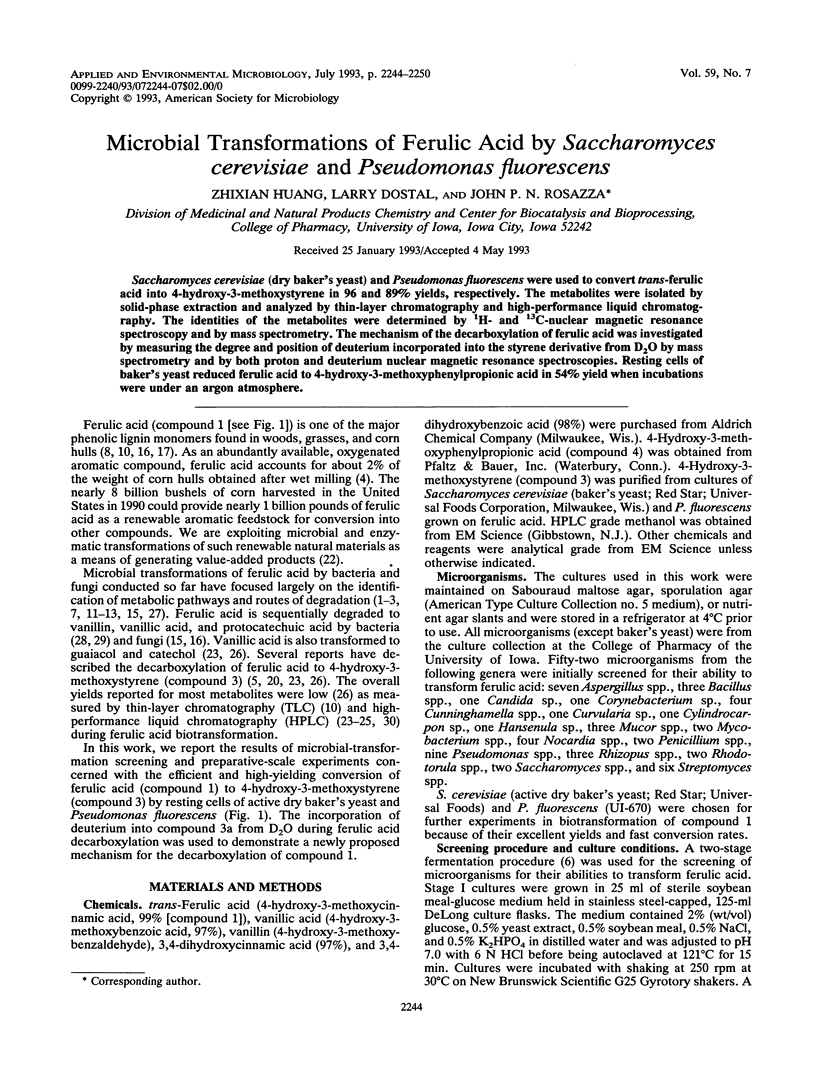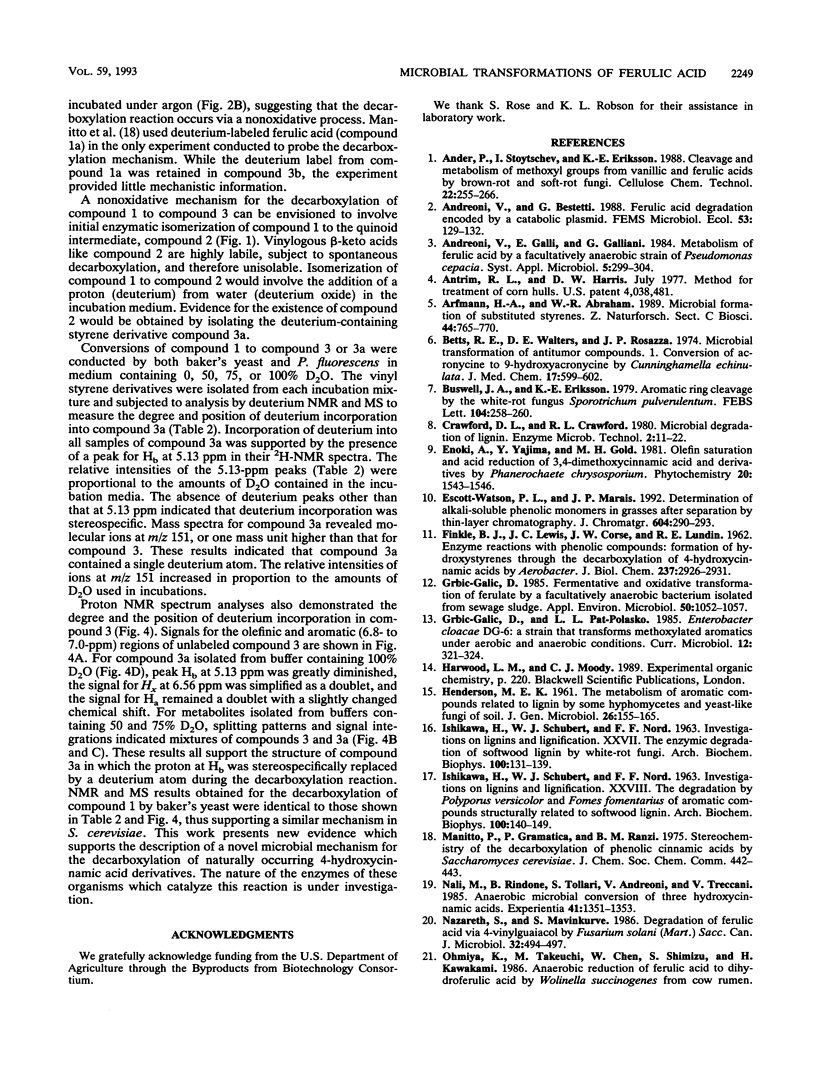Abstract
Saccharomyces cerevisiae (dry baker's yeast) and Pseudomonas fluorescens were used to convert trans-ferulic acid into 4-hydroxy-3-methoxystyrene in 96 and 89% yields, respectively. The metabolites were isolated by solid-phase extraction and analyzed by thin-layer chromatography and high-performance liquid chromatography. The identities of the metabolites were determined by 1H- and 13C-nuclear magnetic resonance spectroscopy and by mass spectrometry. The mechanism of the decarboxylation of ferulic acid was investigated by measuring the degree and position of deuterium incorporated into the styrene derivative from D2O by mass spectrometry and by both proton and deuterium nuclear magnetic resonance spectroscopies. Resting cells of baker's yeast reduced ferulic acid to 4-hydroxy-3-methoxyphenylpropionic acid in 54% yield when incubations were under an argon atmosphere.
Full text
PDF






Selected References
These references are in PubMed. This may not be the complete list of references from this article.
- Betts R. E., Walters D. E., Rosazza J. P. Microbial transformations of antitumor compounds. 1. Conversion of acronycine to 9-hydroxyacronycine by Cunninghamella echinulata. J Med Chem. 1974 Jun;17(6):599–602. doi: 10.1021/jm00252a006. [DOI] [PubMed] [Google Scholar]
- FINKLE B. J., LEWIS J. C., CORSE J. W., LUNDIN R. E. Enzyme reactions with phenolic compounds: formation of hydroxystyrenes through the decarboxylation of 4-hydroxycinnamic acids by Aerobacter. J Biol Chem. 1962 Sep;237:2926–2931. [PubMed] [Google Scholar]
- Grbić-Galić D. Fermentative and oxidative transformation of ferulate by a facultatively anaerobic bacterium isolated from sewage sludge. Appl Environ Microbiol. 1985 Oct;50(4):1052–1057. doi: 10.1128/aem.50.4.1052-1057.1985. [DOI] [PMC free article] [PubMed] [Google Scholar]
- HENDERSON M. E. The metabolism of aromatic compounds related to lignin by some hyphomycetes and yeast-like fungi of soil. J Gen Microbiol. 1961 Sep;26:155–165. doi: 10.1099/00221287-26-1-155. [DOI] [PubMed] [Google Scholar]
- ISHIKAWA H., SCHUBERT W. J., NORD F. F. Investigations on lignins and lignification. 27. The enzymic degradation of softwood lignin by white-rot fungi. Arch Biochem Biophys. 1963 Jan;100:131–139. doi: 10.1016/0003-9861(63)90043-2. [DOI] [PubMed] [Google Scholar]
- ISHIKAWA H., SCHUBERT W. J., NORD F. F. Investigations on lignins and lignification. 28. The degradation by Polyporus versicolor and Fomes fomentarius of aromatic compounds structurally related to softwood lignin. Arch Biochem Biophys. 1963 Jan;100:140–149. doi: 10.1016/0003-9861(63)90044-4. [DOI] [PubMed] [Google Scholar]
- Rahouti M., Seigle-Murandi F., Steiman R., Eriksson K. E. Metabolism of Ferulic Acid by Paecilomyces variotii and Pestalotia palmarum. Appl Environ Microbiol. 1989 Sep;55(9):2391–2398. doi: 10.1128/aem.55.9.2391-2398.1989. [DOI] [PMC free article] [PubMed] [Google Scholar]
- Rouseff R. L., Dettweiler G. R., Swaine R. M., Naim M., Zehavi U. Solid-phase extraction and HPLC determination of 4-vinyl guaiacol and its precursor, ferulic acid, in orange juice. J Chromatogr Sci. 1992 Oct;30(10):383–387. doi: 10.1093/chromsci/30.10.383. [DOI] [PubMed] [Google Scholar]
- Seigle-Murandi F., Steiman R., Rahouti M., Benoit-Guyod J. L., Eriksson K. E. Metabolism of ferulic and syringic acids by micromycetes. Microbiologica. 1990 Jul;13(3):191–200. [PubMed] [Google Scholar]
- Sutherland J. B., Crawford D. L., Pometto A. L., 3rd Metabolism of cinnamic, p-coumaric, and ferulic acids by Streptomyces setonii. Can J Microbiol. 1983 Oct;29(10):1253–1257. doi: 10.1139/m83-195. [DOI] [PubMed] [Google Scholar]
- Toms A., Wood J. M. The degradation of trans-ferulic acid by Pseudomonas acidovorans. Biochemistry. 1970 Jan 20;9(2):337–343. doi: 10.1021/bi00804a021. [DOI] [PubMed] [Google Scholar]


